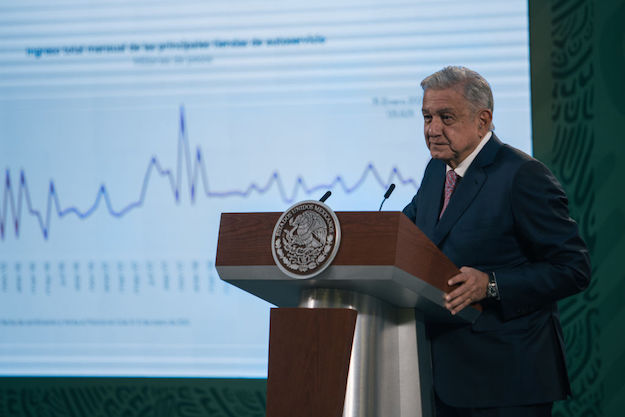On Feb. 16, a day after a winter storm-related energy crisis left more than 4 million Mexicans without electricity, President Andrés Manuel López Obrador tried to seize the moment. “What is the lesson in all of this? We must produce,” the president said in one of his daily press briefings.
The president, popularly known as AMLO, went on to blame the country’s dependence on natural gas imports from the U.S. The blackout, he said, was further proof of a need for Mexican energy self-sufficiency.
But the President’s nationalistic energy policy — a push to re-establish state control over energy markets — will not produce the self-sufficiency he seeks. It will instead deepen the country’s dependence on international inputs and pollutive energy sources, further hindering the efficiency of an already strained domestic energy market operation. His administration should drop its ideological policy and recognize that the energy sector’s performance lies at the heart of the economy’s long-term competitiveness and productivity. It is diversification and not concentration that will make Mexico more competitive and less dependent in terms of energy.
Mexico’s 2013 energy reform, approved under then-President Enrique Peña Nieto, for all its flaws, represented a rational, comprehensive and sustainable plan. It targeted declining oil and gas production and the resulting increase in imports; it addressed the issue of scarce investment in renewables as well as that of outdated technology and infrastructure; it even tackled the lack of good corporate governance at Pemex and CFE, Mexico’s primary state-owned energy companies.
The president’s move to embrace the two giants, as well as his efforts to cast doubt on the merit of renewables and the need for private company participation in energy markets, is out of touch with economic reality and environmental world trends.
Pemex, despite recovering a certain degree of financial stability with the implementation of its 2017 business plan, has since become deeply vulnerable. Since April of last year, Pemex’s investment ranking has plummeted from investment grade to junk, making it the largest “fallen angel” in the world. The fallout has impacted Mexico’s federal budget revenues and public finances as a whole. According to the ratings agency Moody’s, the government will need to inject almost $15 billion in 2021 to maintain production at its current, historically-low levels, at a time where the firm’s financial debt is of $107 billion and unfunded pension liabilities are close to $80 billion.
Meanwhile, as the rest of the world looks to transition from fossil fuels to renewables — and as, owing to a lack of investment, Mexico’s six existing refineries produce well below capacity — the government dedicates scarce fiscal resources to the construction of a new refinery, the current administration’s pet project Dos Bocas. The fact that the four international companies invited to participate in the Dos Bocas refinery declined to bid once the feasibility studies were finalized speaks volumes: The analysis demonstrated that the project’s finances and timing were all but unworkable.
Likewise, the electricity market has little to offer. In May 2020, the Ministry of Energy issued a National Electrical System Policy (PRSCQ), granting the government greater control over who can generate power. The policy, received with understandable backlash from private energy producers, returned the state-owned CFE to a position of energy dominance. It also created a vicious cycle. CFE would begin buying fuel oil from Pemex refineries rather than renewable sources, producing expensive and highly pollutive electricity rather than procuring more efficient, cleaner sources.
The deceitful and simplistic narrative behind the new policy pushed the falsehood that wind and solar energies, supposedly less stable than oil and gas, would compromise Mexican energy security. The move brought to mind AMLO’s visit to Tijuana last year, when the president had stopped along the highway to broadcast a video showing how “private-sector energy windmills” affected the otherwise beautiful natural landscape.
Although the Federal Competition Commission ordered a review into several elements of the PRSCQ last year — a review bolstered by a Supreme Court ruling that affirmed the Policy violates the right to free competition and gives undue advantage to CFE — the current government has enhanced measures that would again see Mexico reverse course, further cementing state power in energy markets.
Just three days before the Supreme Court ruling, the president had introduced a bill to Congress that would grant the PRSCQ legal support. The bill argues that constitutional and legal changes adopted under the previous administration were plagued by corruption. The proposal, whose ideology-driven tone should raise red flags, would create a dangerous precedent, threatening to eliminate private participation in the electricity sector on the basis of unproven corruption allegations.
The bill also establishes a perverse energy priority, giving preference first to hydroelectric plants (which account only for 21% of current input to the electric network), then CFE plants (the core of the plan), saving renewables and “private sources” for last. In its own language, the bill argues that “the privatization process has weakened public enterprises, transferred them to the private sector, and stripped away Mexicans’ oil wealth and the national electrical industry.”
If materialized, these legal changes will affect energy security in Mexico. The bill would change the incentives from efficiency-based power generation to prioritizing CFE regardless of the increased costs, the fact that it is intensive in coal and other fossil fuels and that this production and dispatch scheme is far more unstable and less secure.
In the wake of the Supreme Court ruling and international pressure (the U.S. Chamber of Commerce has said the reinstatement of a monopoly in the Mexican electricity sector would violate tenets of the U.S.-Mexico-Canada Agreement, USMCA), it remains to be seen what sort of narrative the Mexican government will adopt. But, as far as passage goes, with AMLO’s MORENA party and its allies having a majority in both houses, the bill could sail through Congress in the coming months. Deeper constitutional changes could then take place after June’s midterm elections, with the administration dealing from the Supreme Court ruling’s fallout in the meantime.
The bill, in seeking to re-establish state control over the energy market, ultimately damages Mexico’s chances at taking advantage of the deep potential its energy matrix possesses. For consumers, the bill would likely mean higher energy prices or higher subsidies — the latter drawing from taxpayer dollars — increasingly frequent electricity outages akin to those we have seen this week; water shortages owing to hydroelectric contamination and inefficiency; and higher degrees of air, water and land pollution, with damaging effects to the health of Mexicans and their families.
The administration, rather than prioritizing ideology and electoral considerations over rule of law and the country’s economic and environmental health, should pause to consider the long-term consequences that lay ahead. Mexico’s development is at stake.








